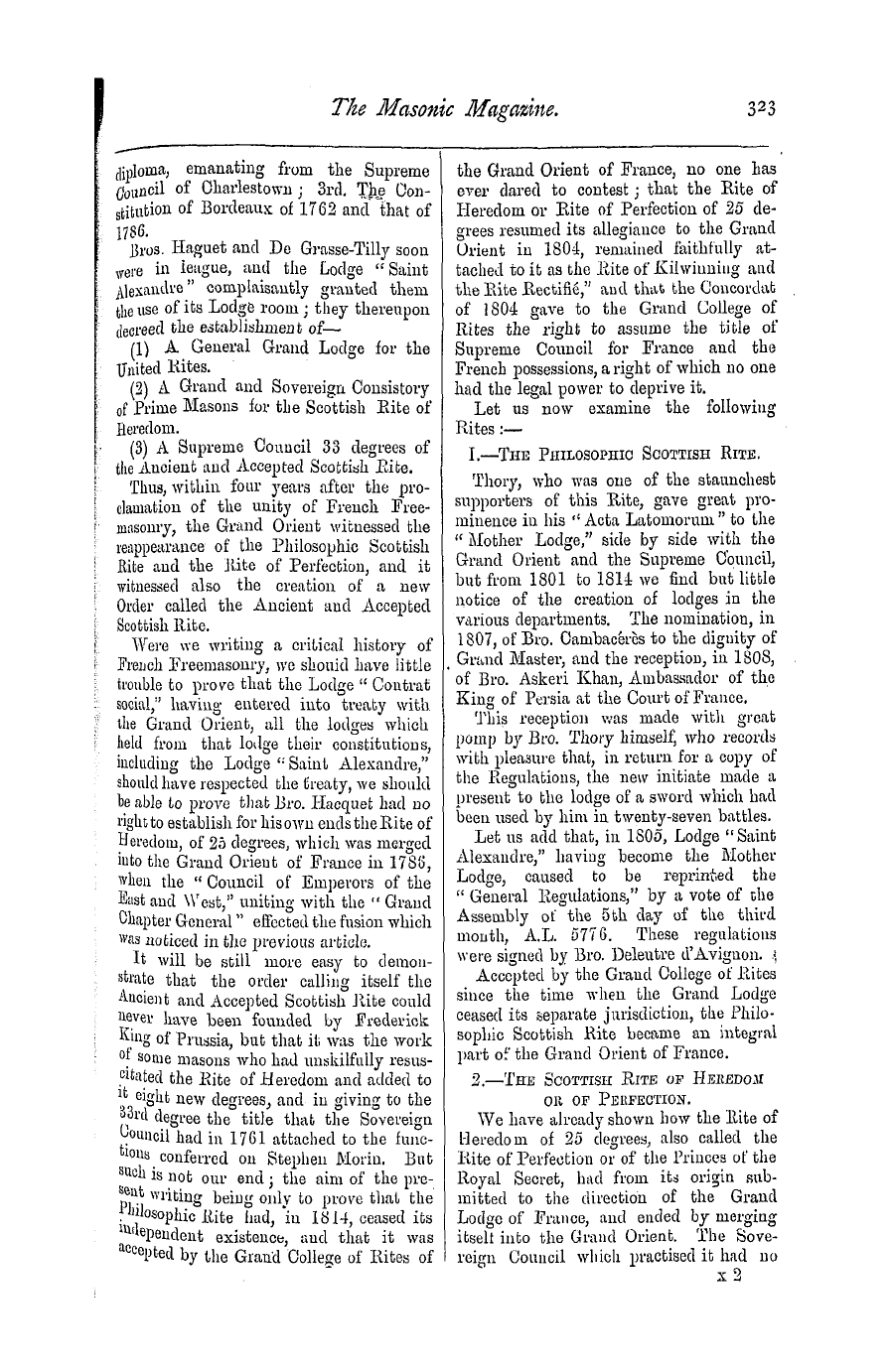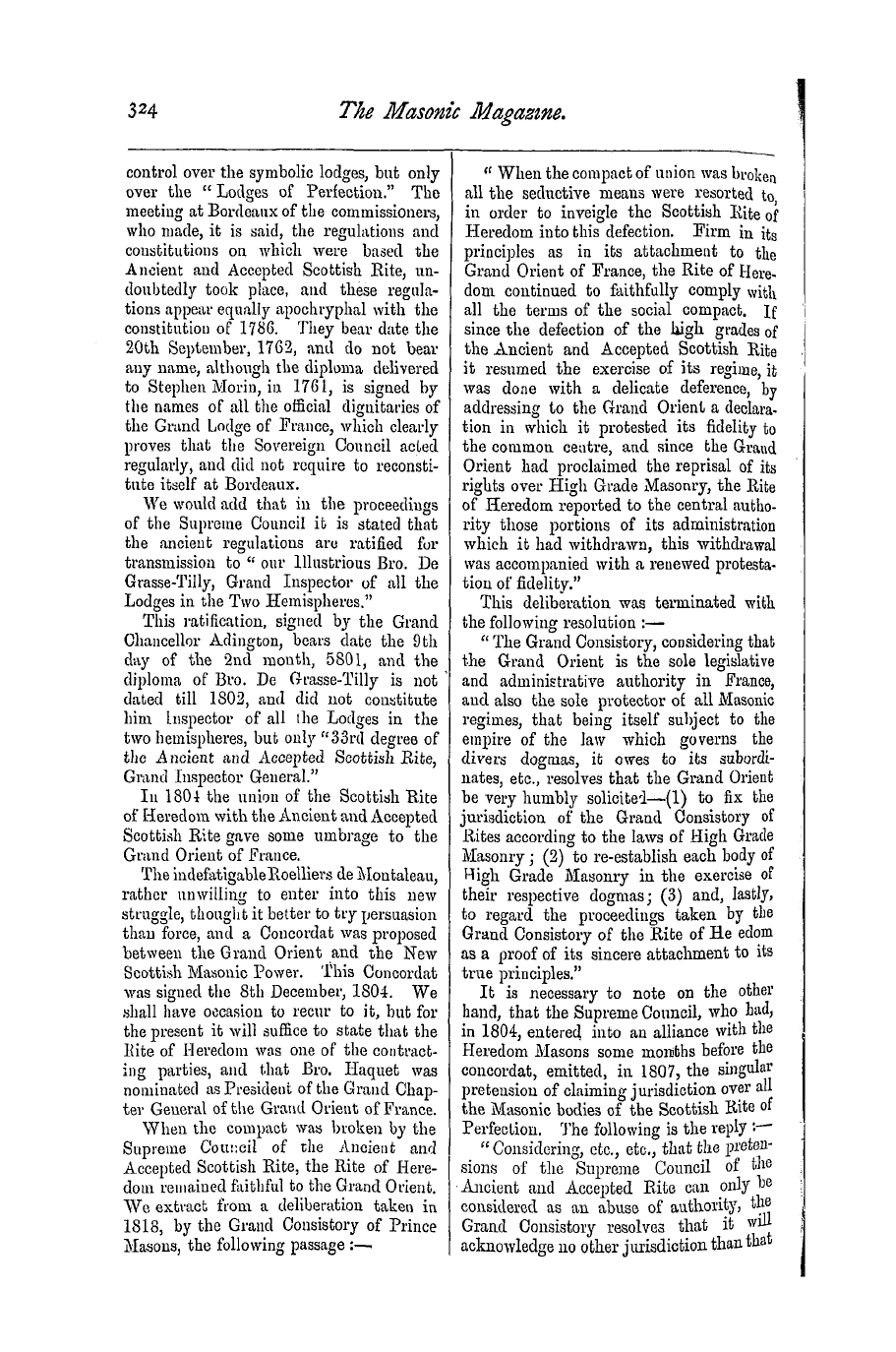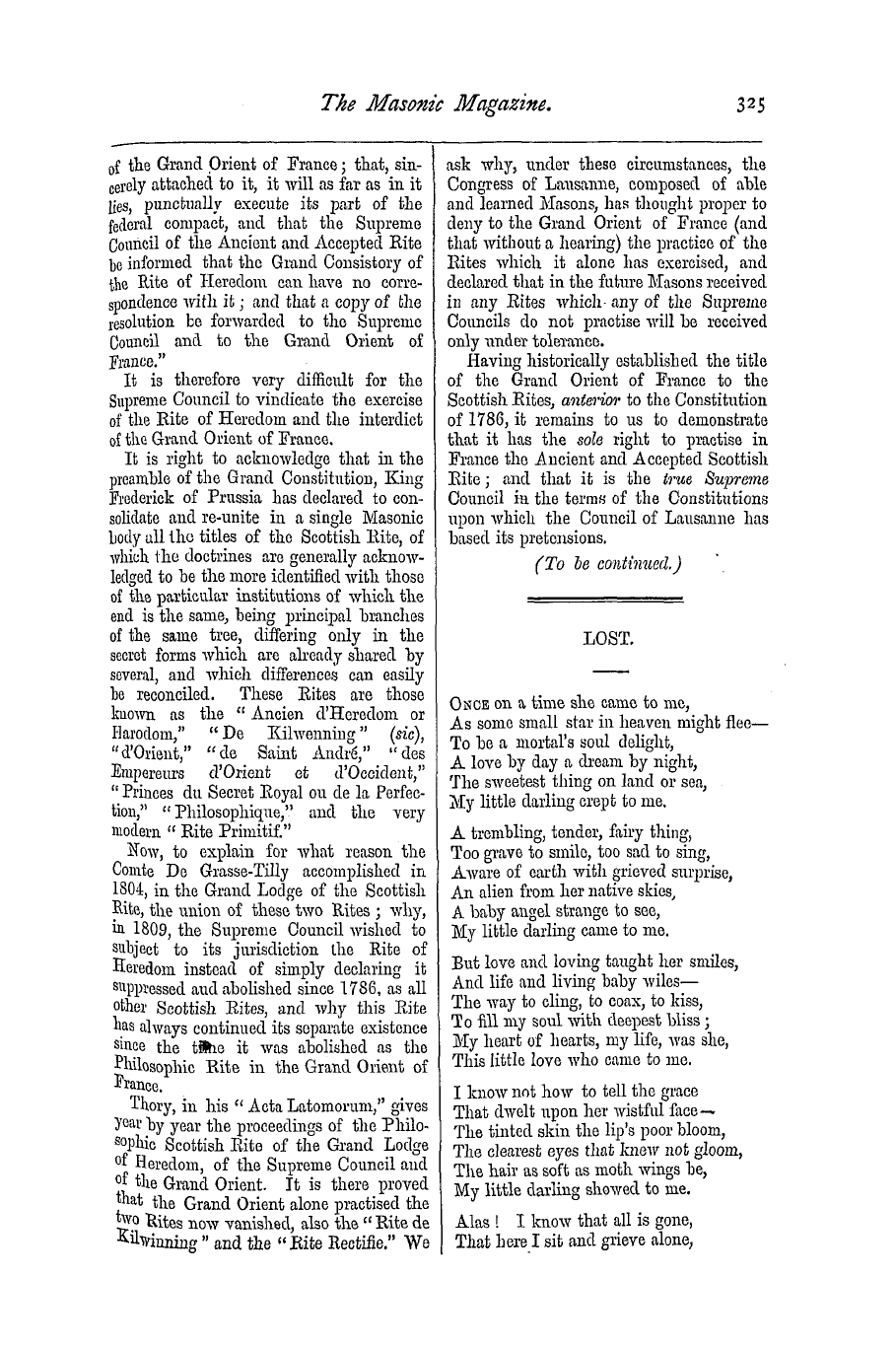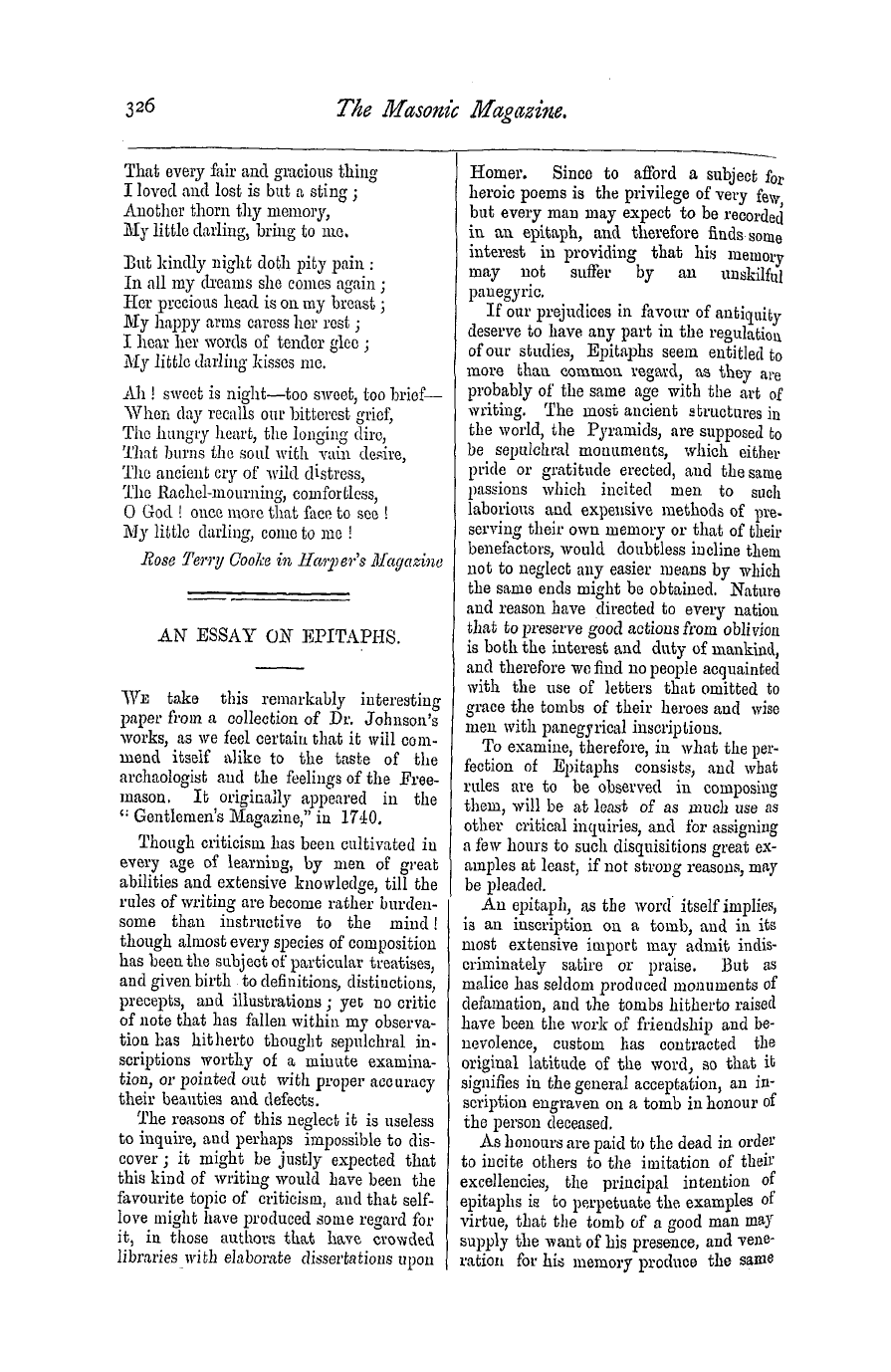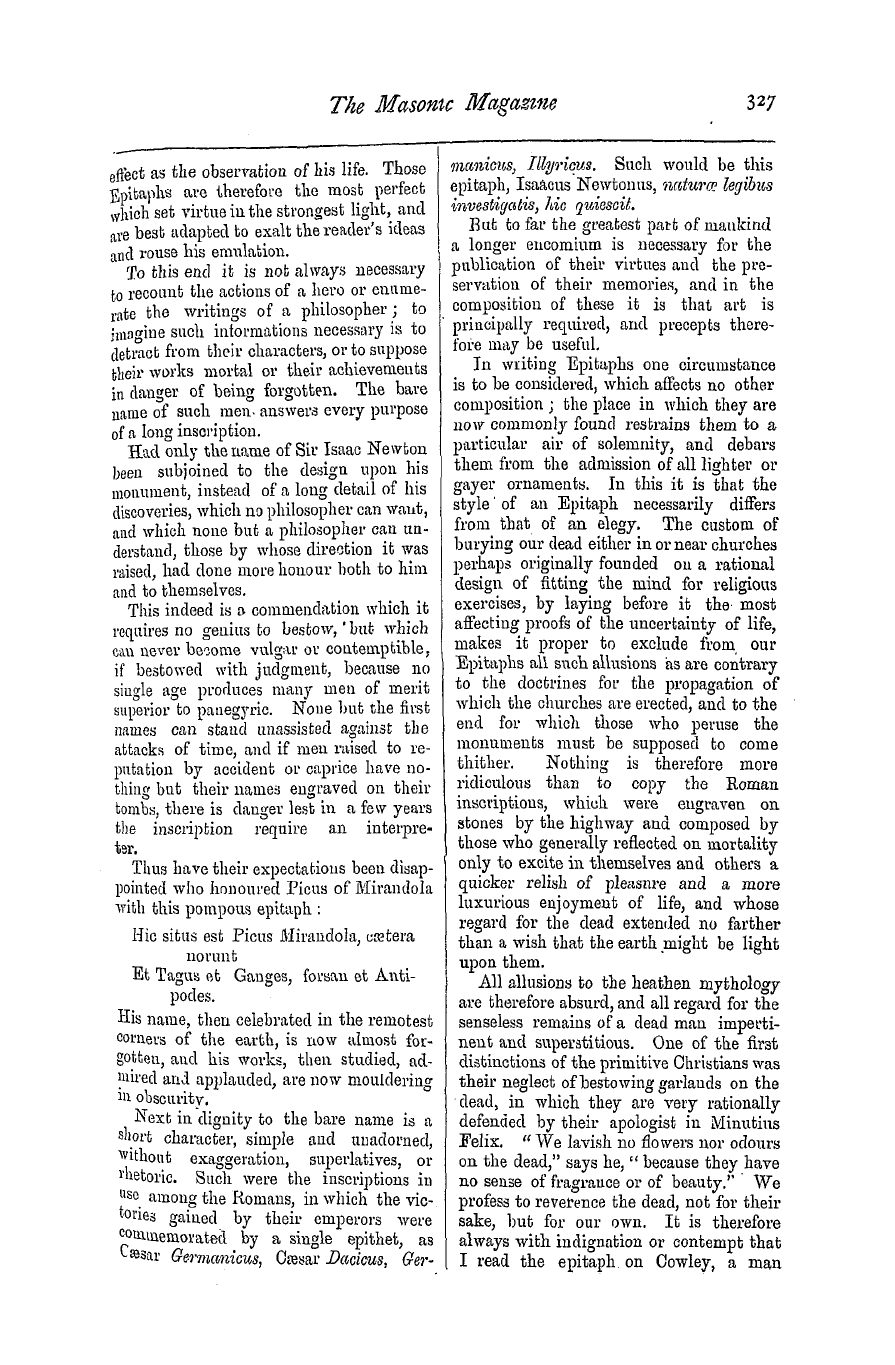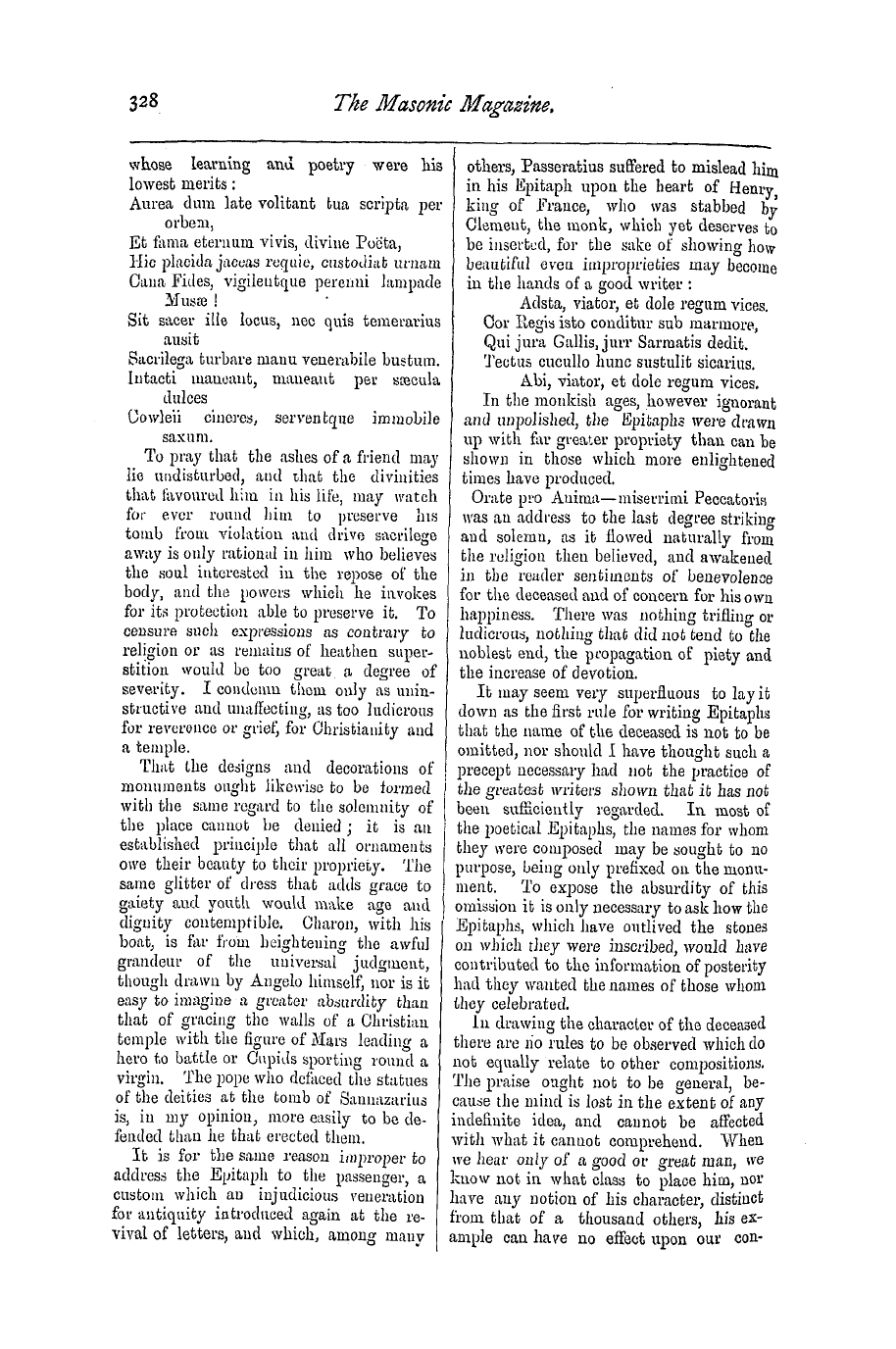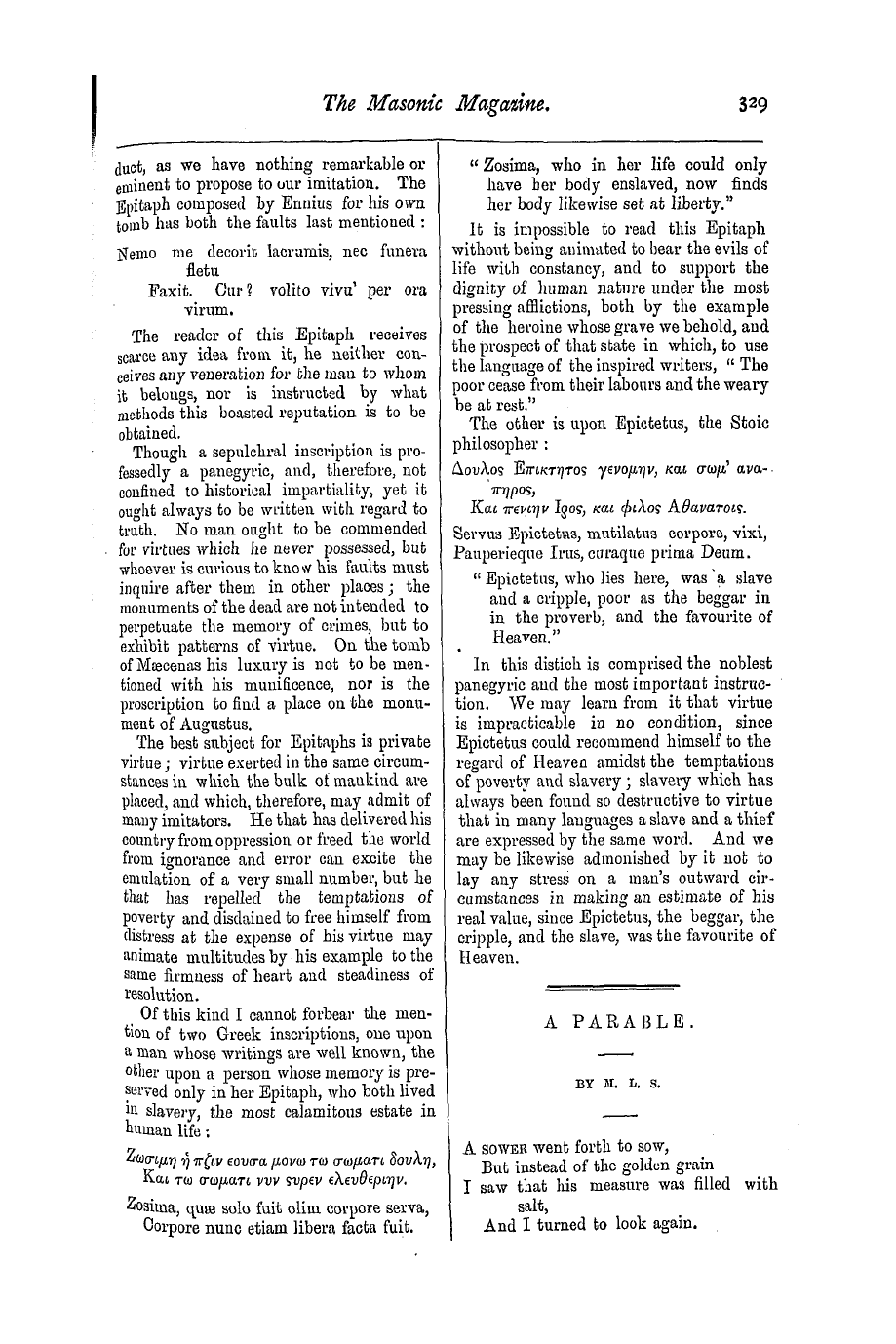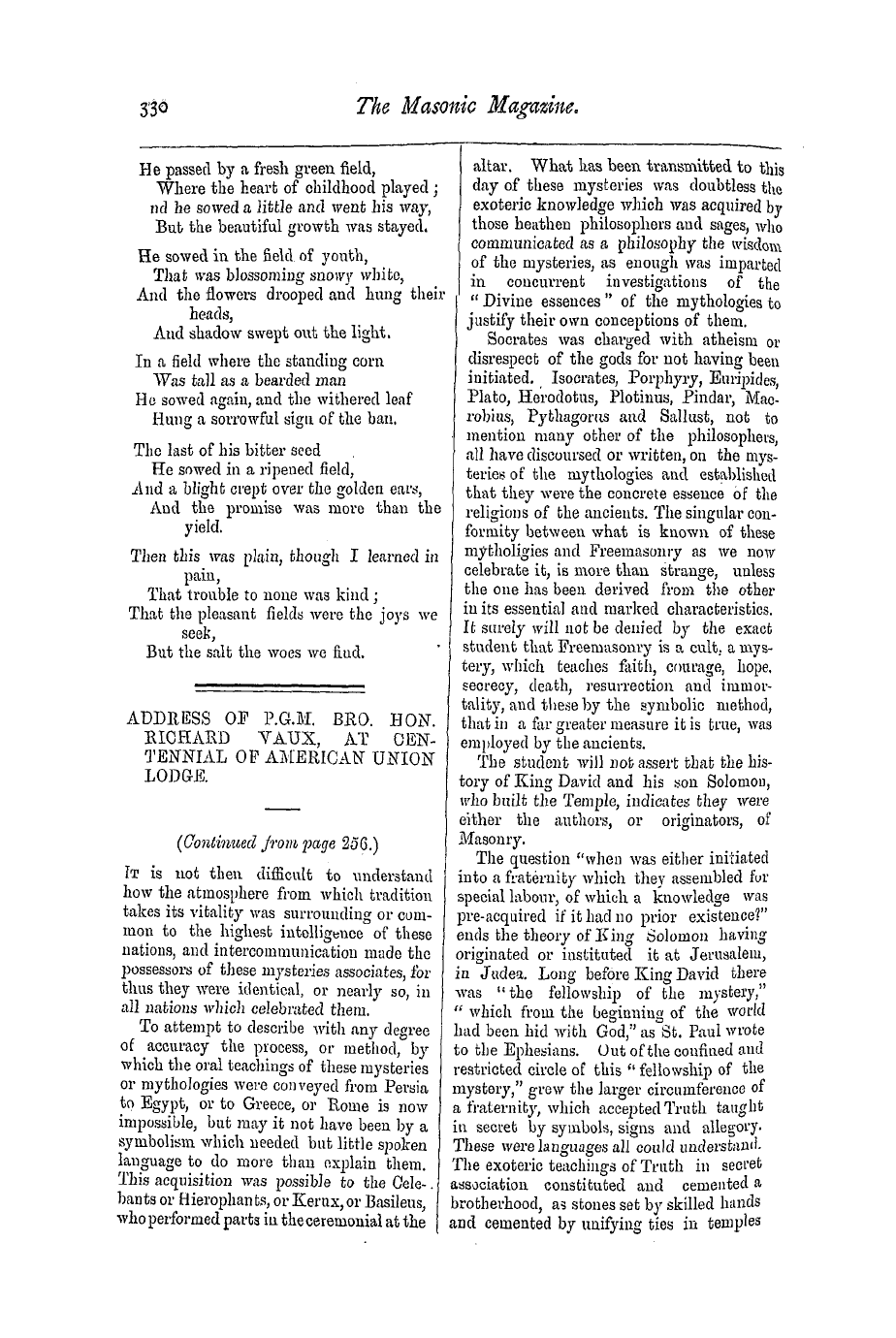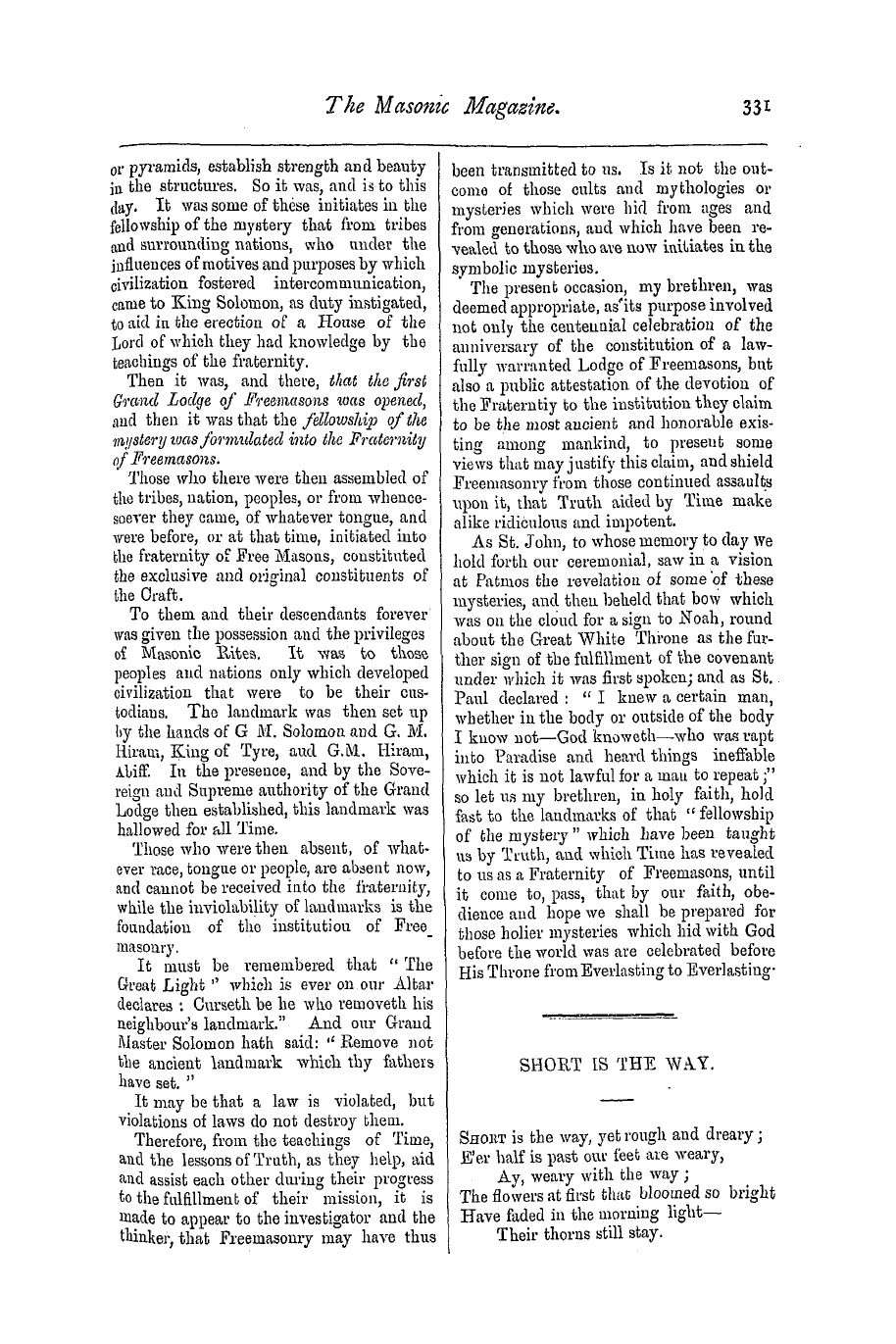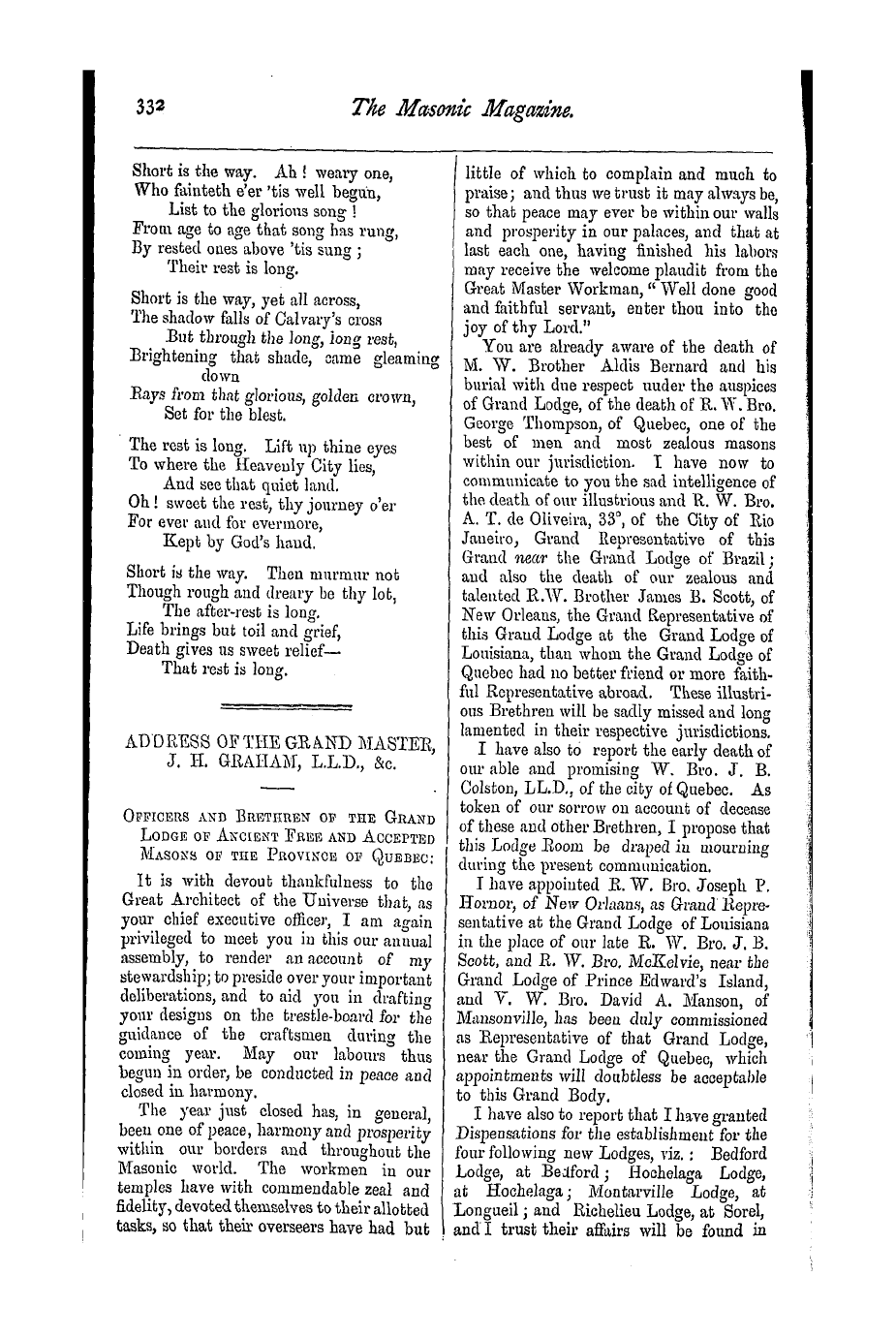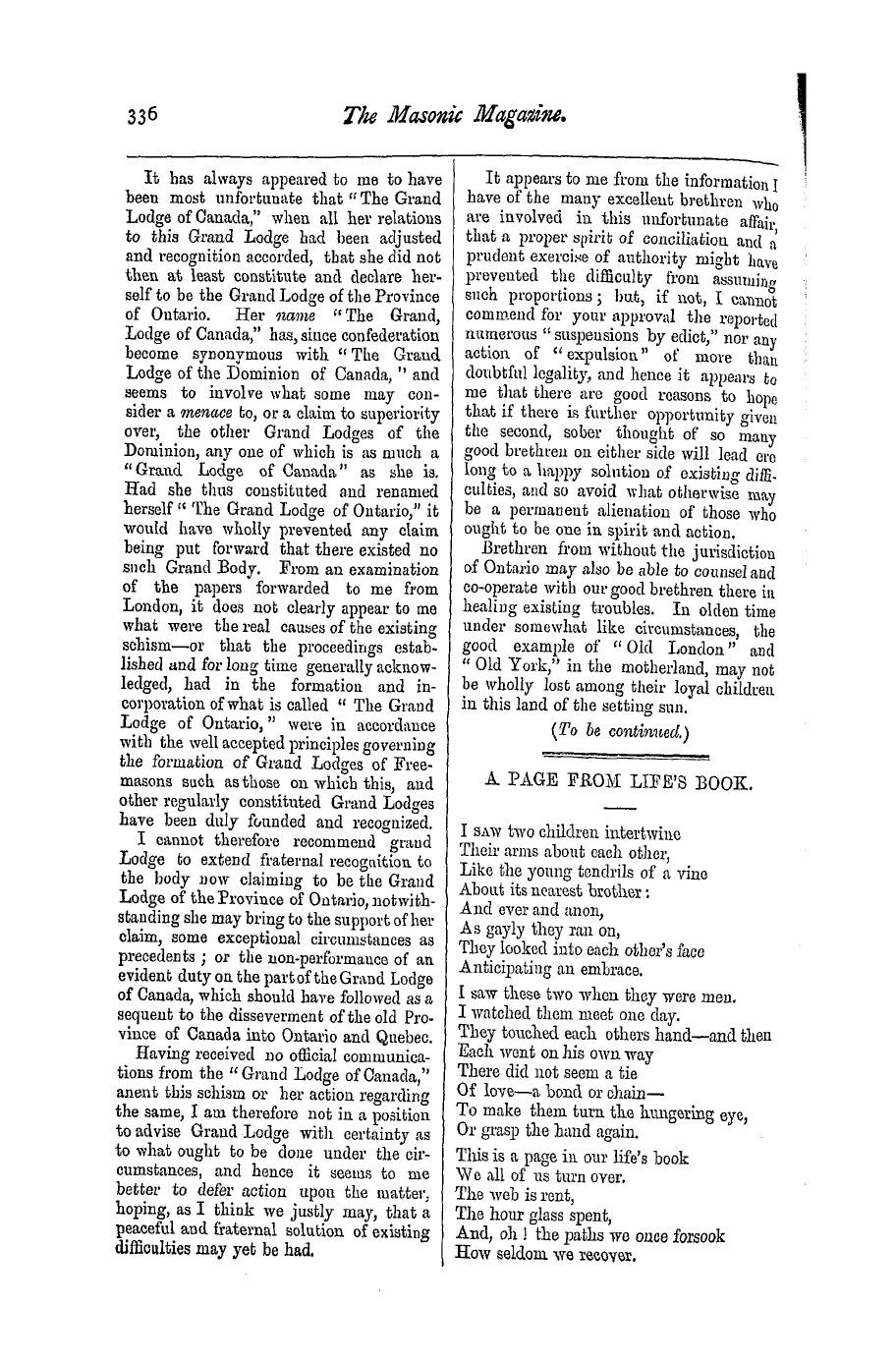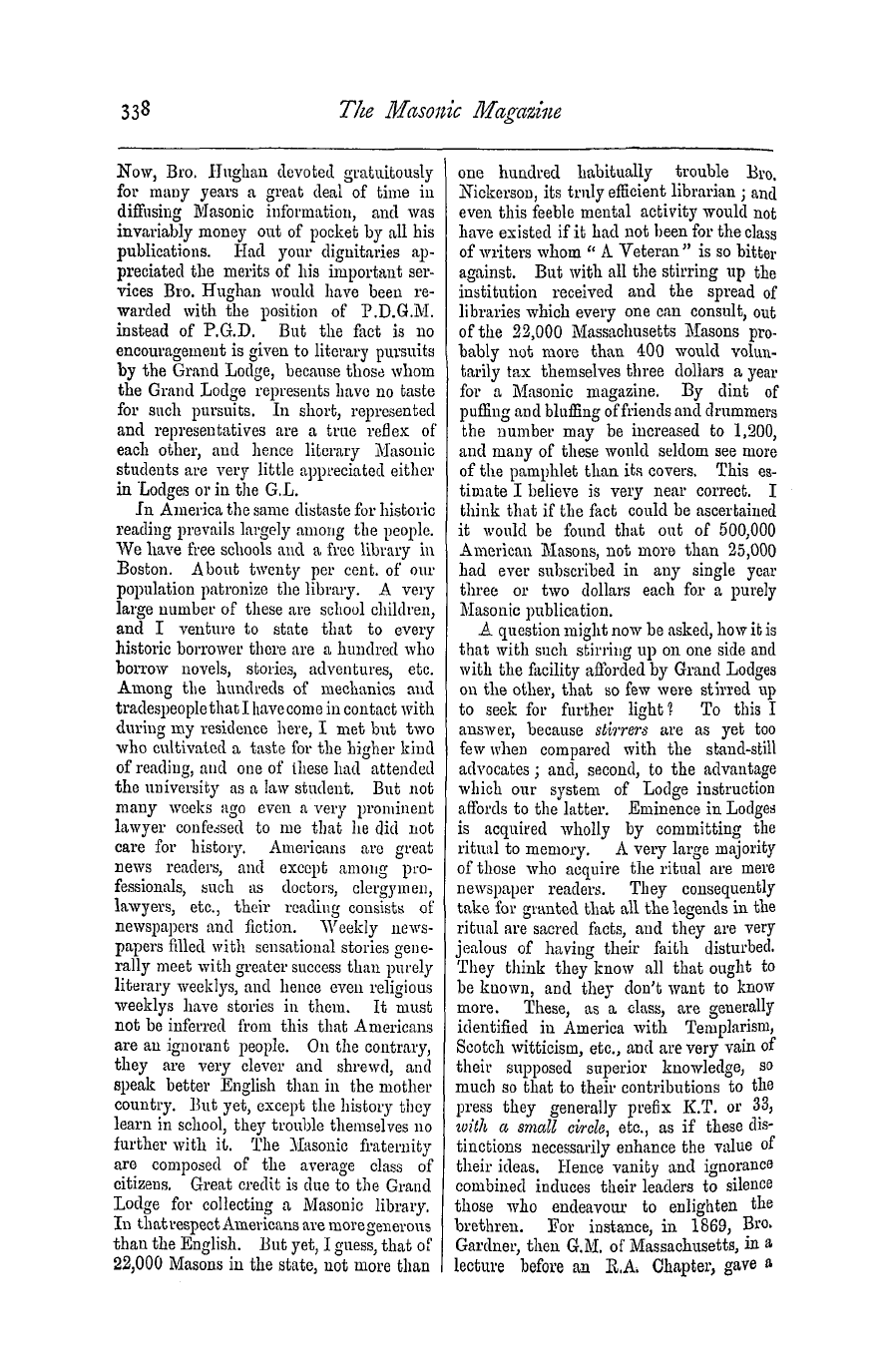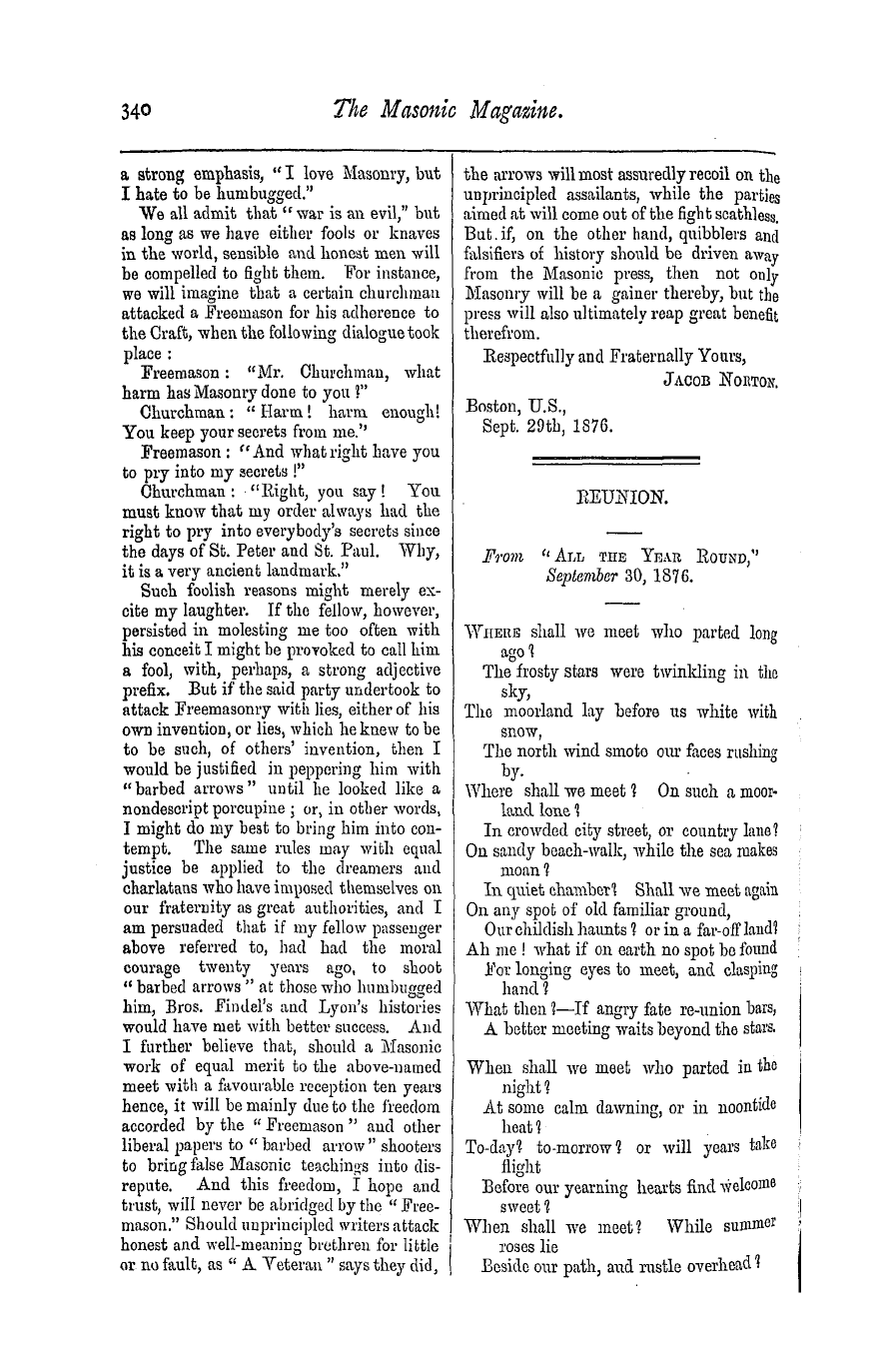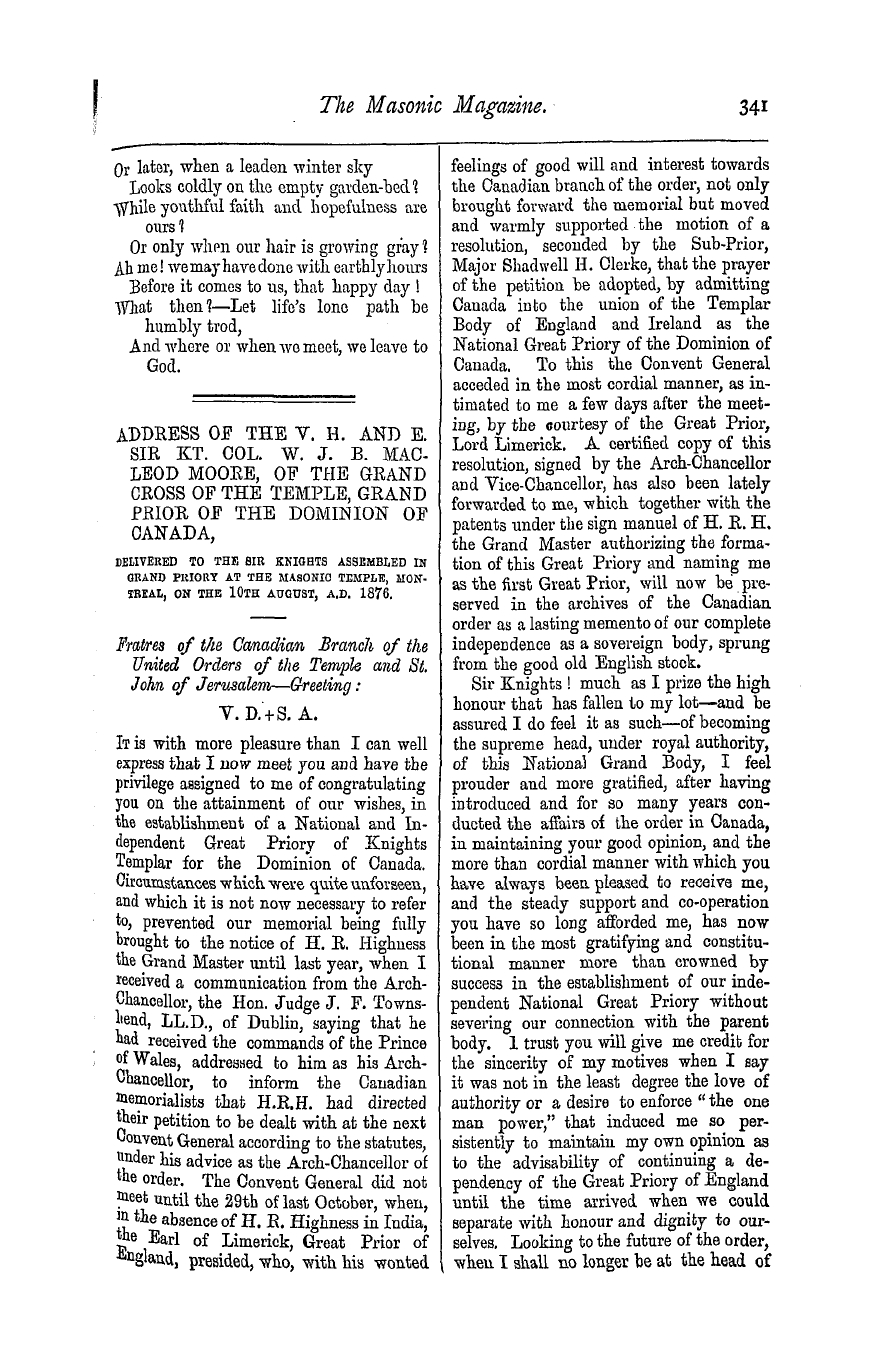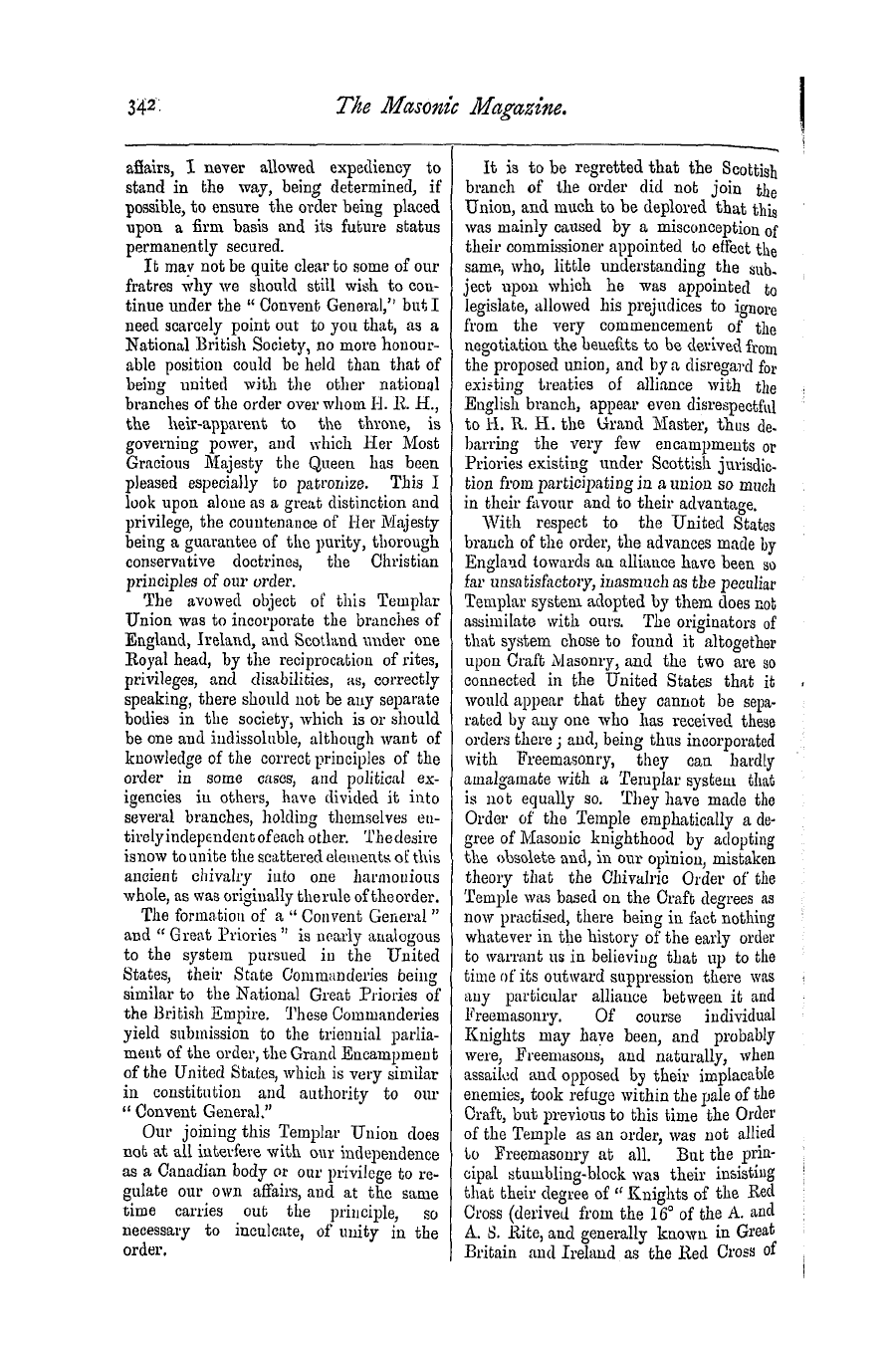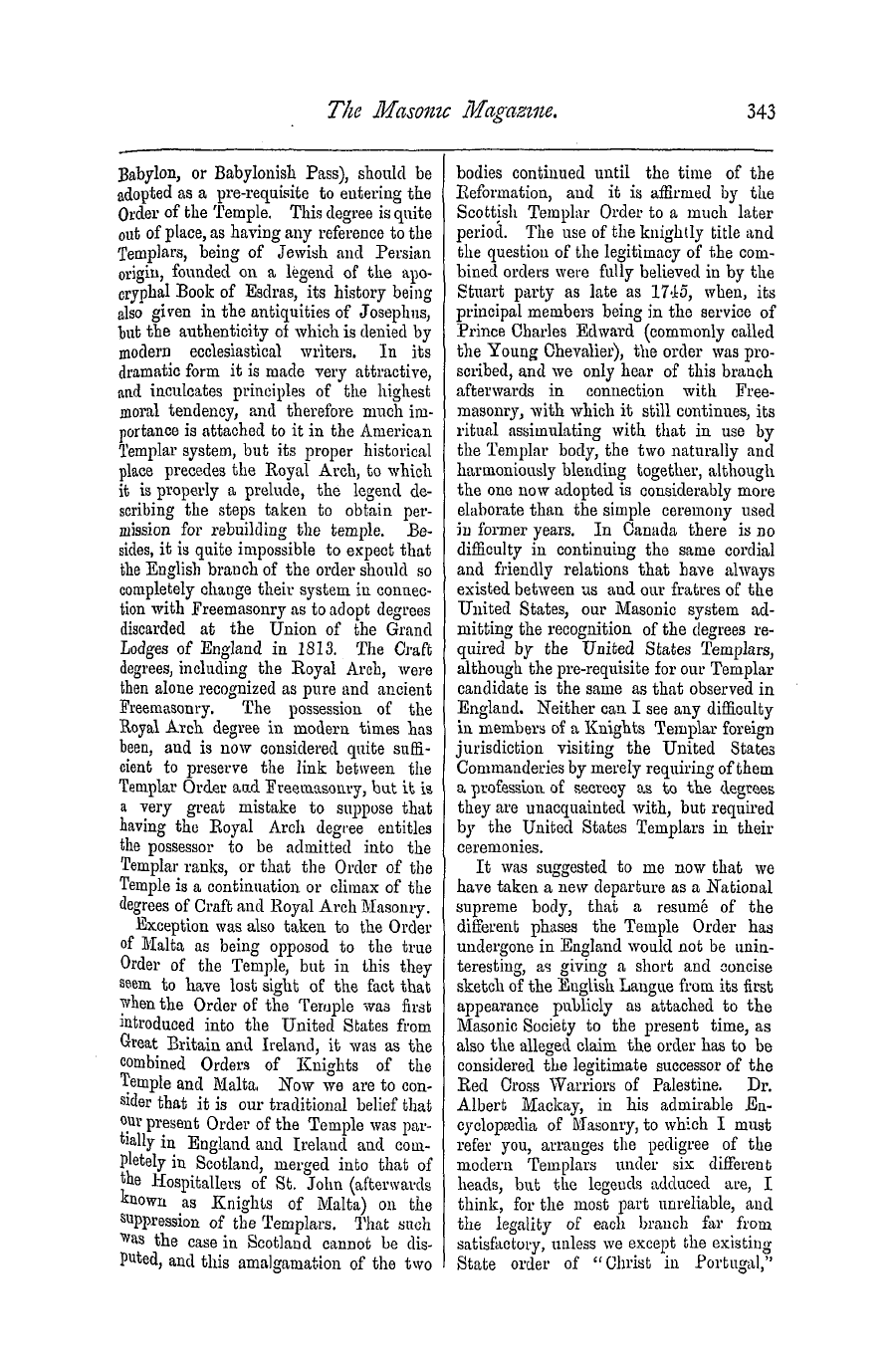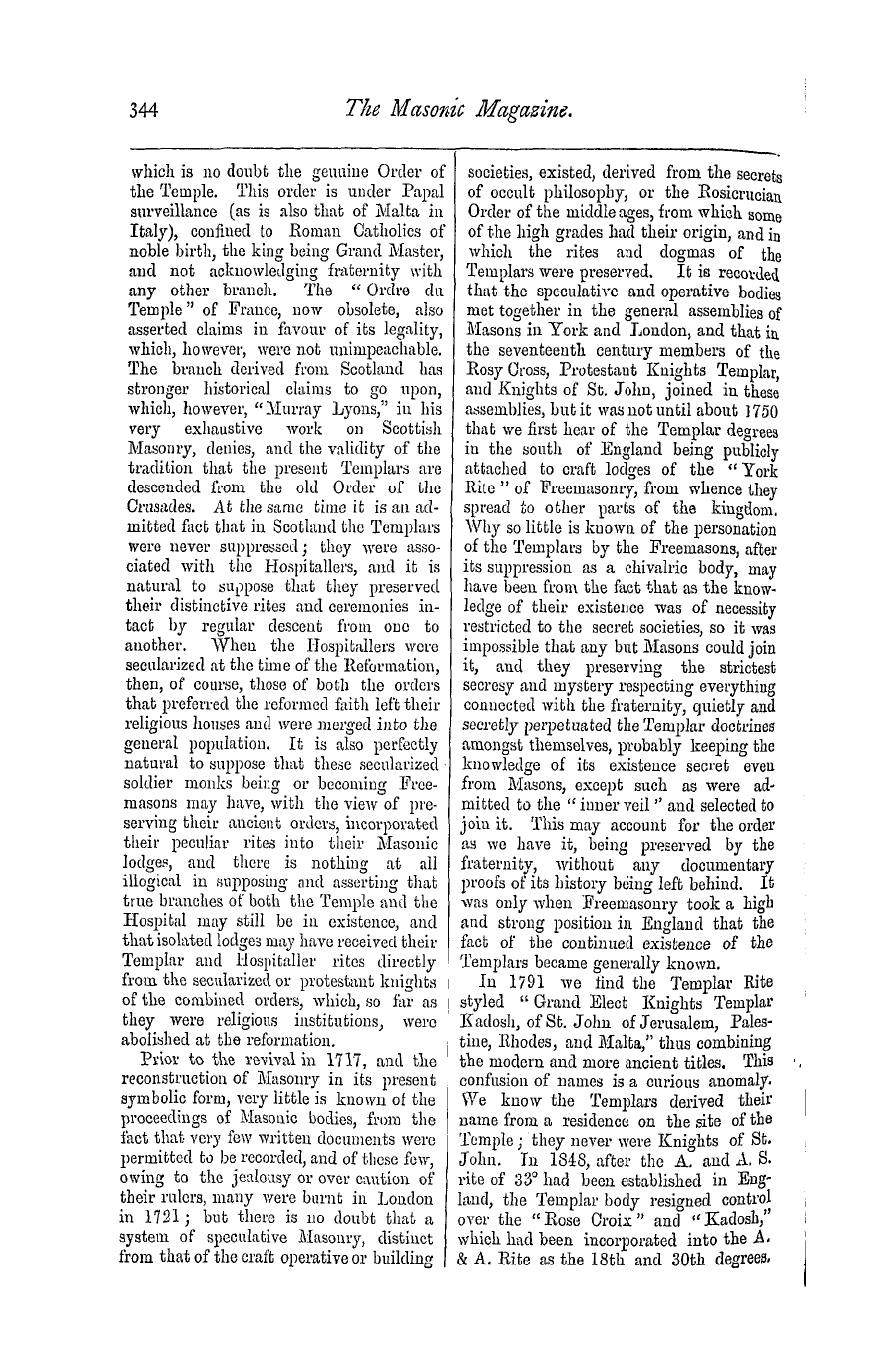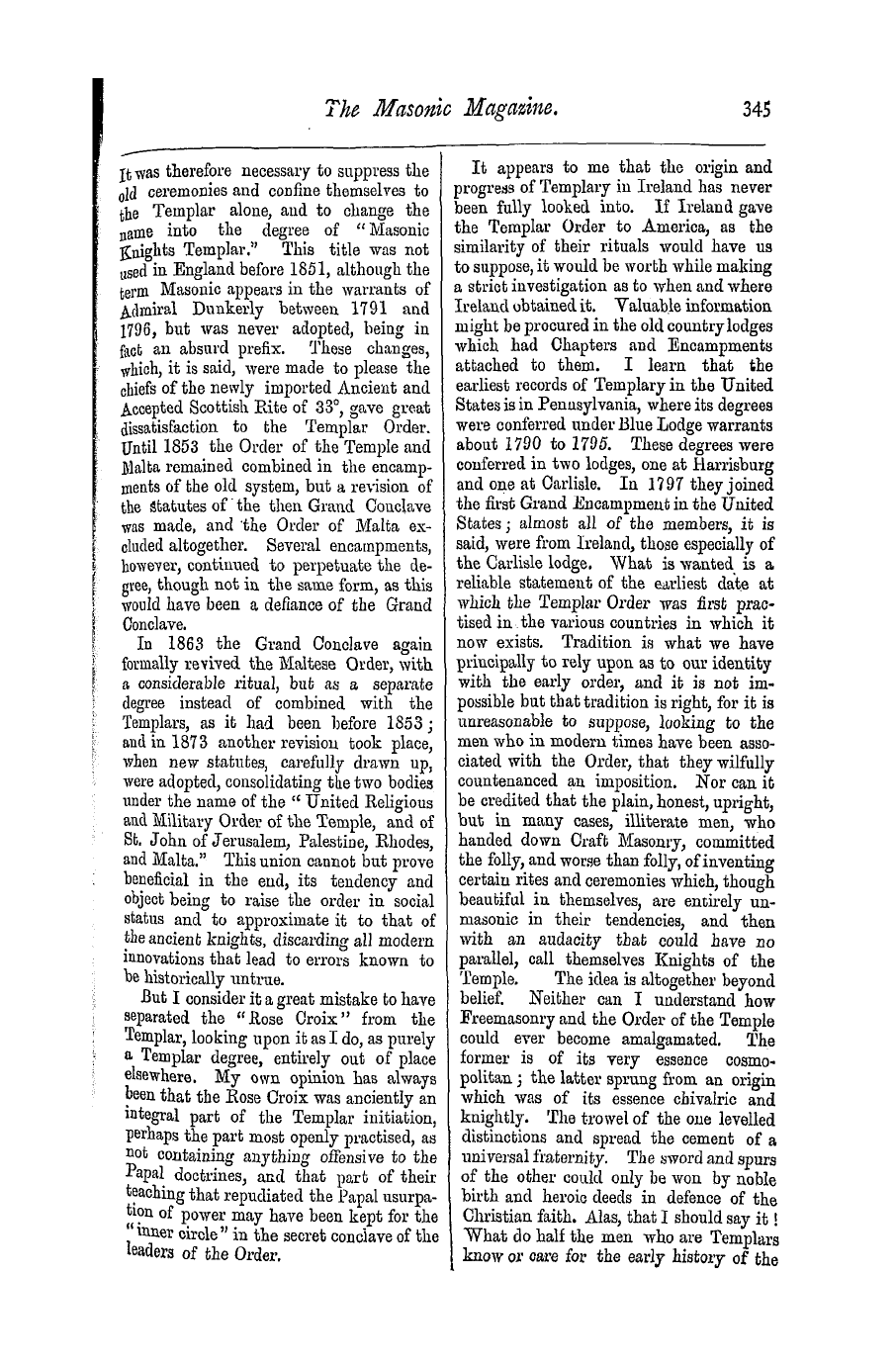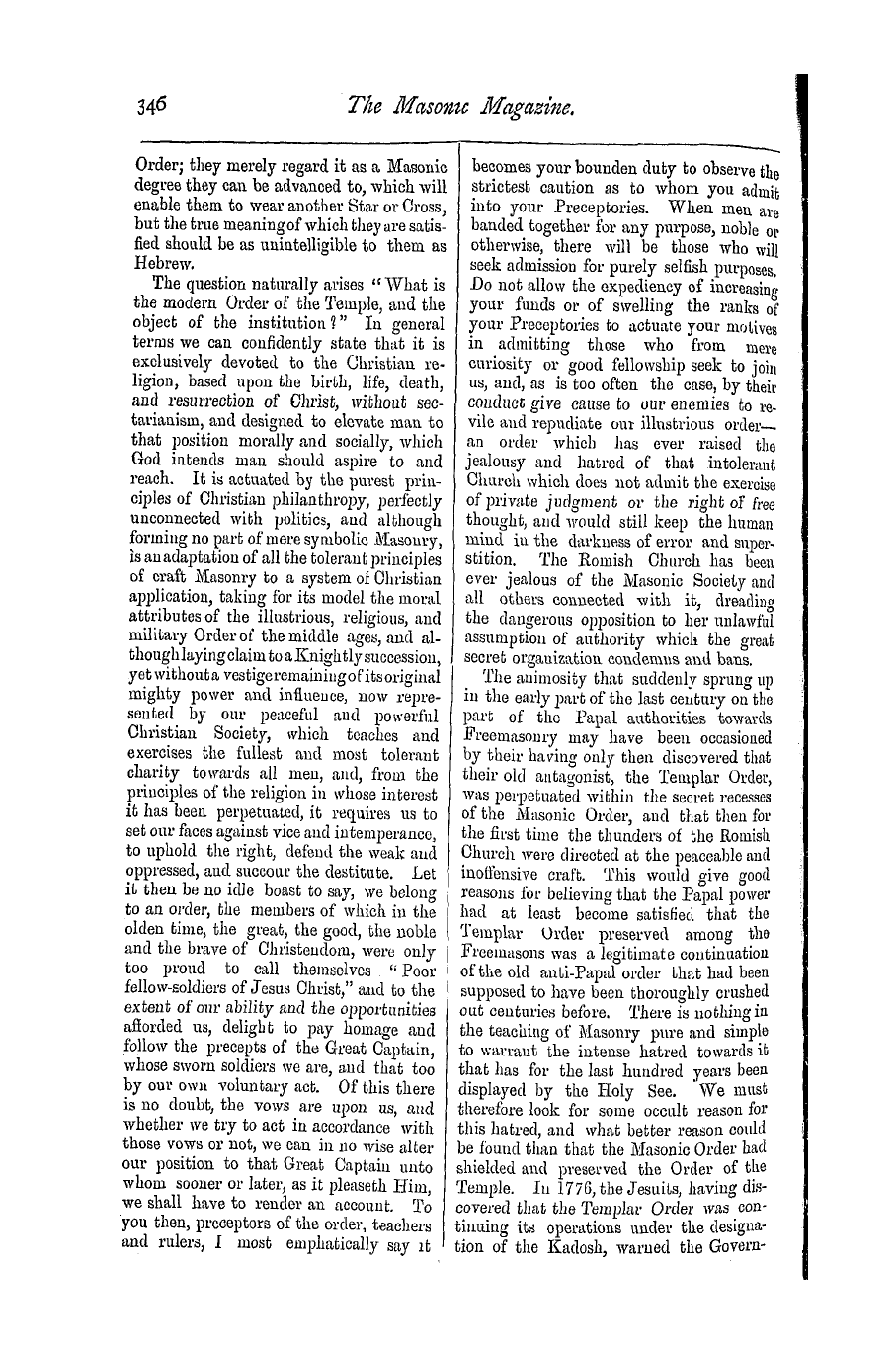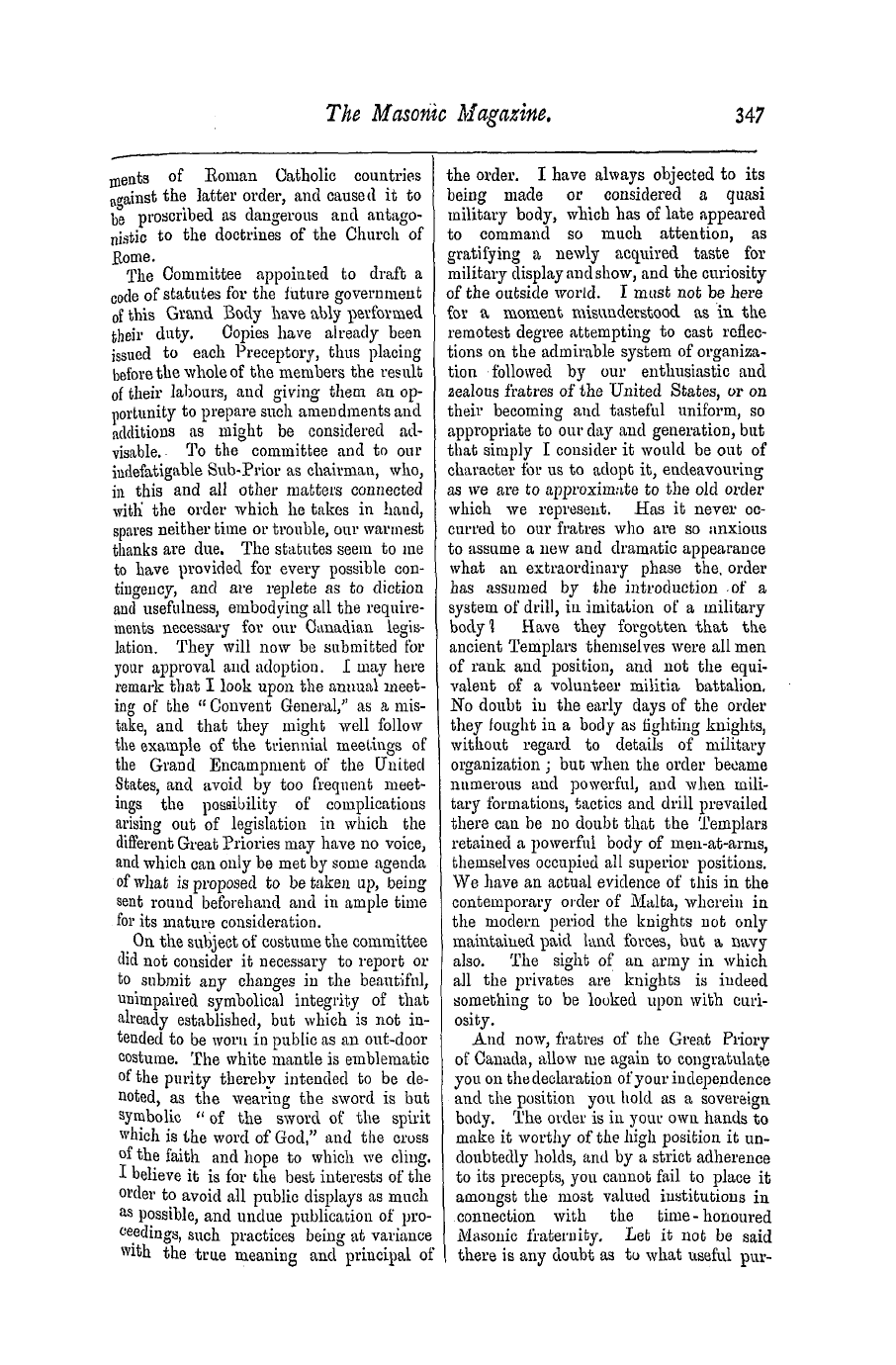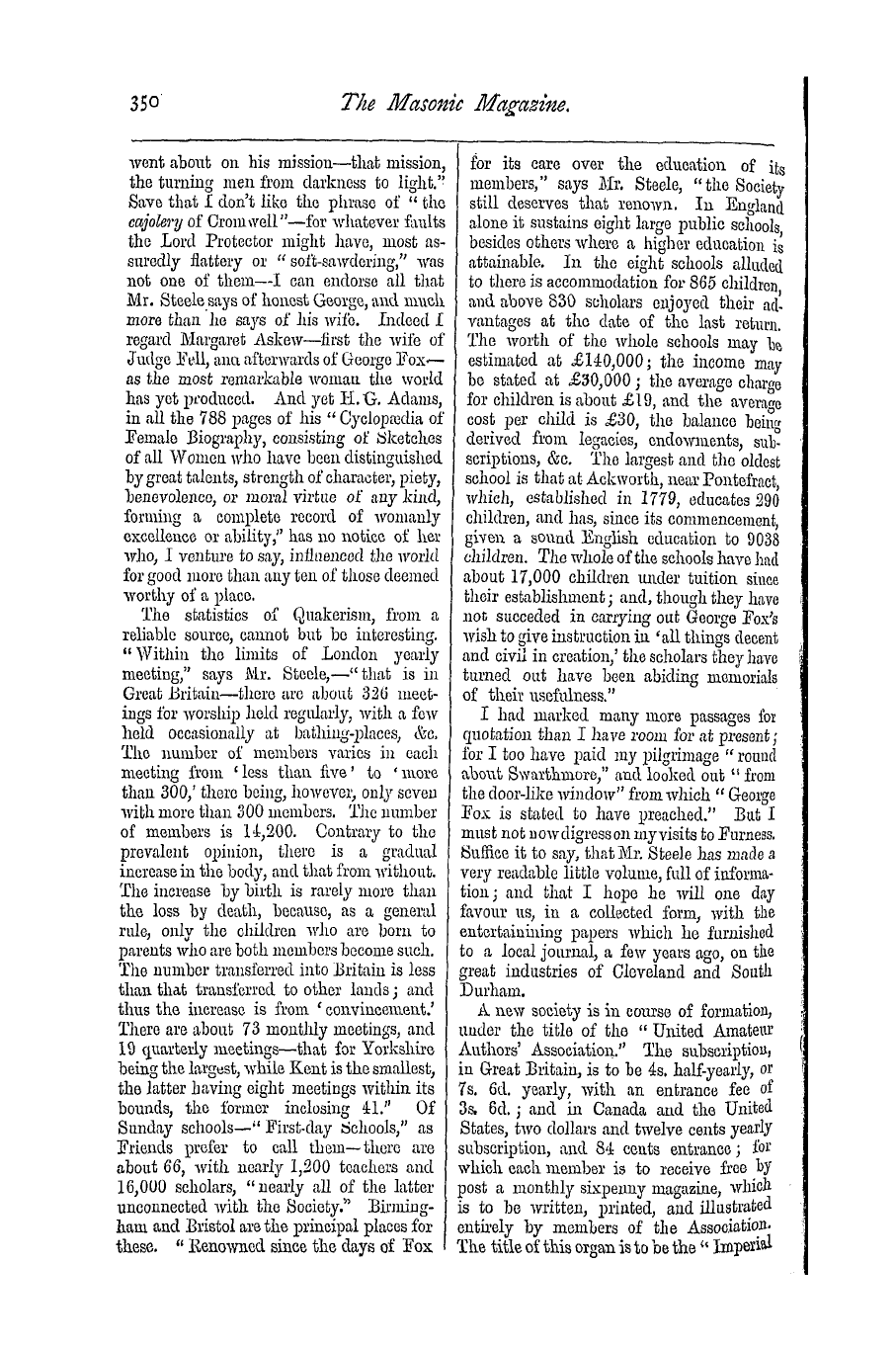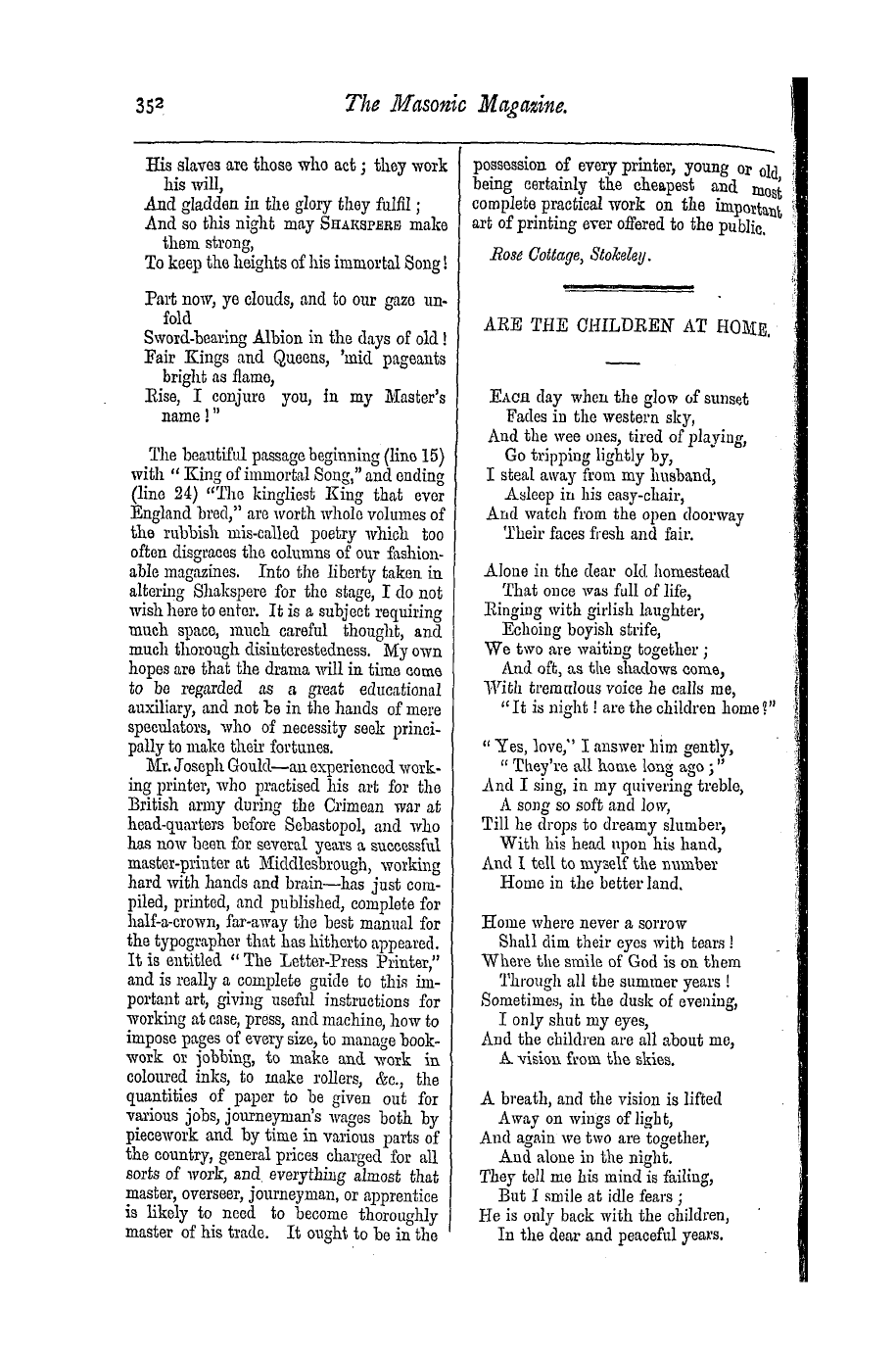Note: This text has been automatically extracted via Optical Character Recognition (OCR) software.
Address Of The V. H. And E. Sir Kt. Col. W. J. B. Macleod Moore, Of The Grand Cross Of The Temple, Grand Prior Of The Dominion Of Canada,
which is no doubt the genuine Order of the Temple . This order is under Papal surveillance ( as is also that of Malta in Italy ) , confined to Roman Catholics of noble birth , the king being Grand Master , and not acknowledging fraternity with
any other branch . The " Oi ' clre du Temple" of France , now obsolete , also asserted claims in favour of its legality , which , however , were not unimpeachable . The branch derived from Scotland has
stronger historical claims to go upon , which , however , "Murray Lyons , " in bis very exhaustive work on Scottish Masonry , denies , and the validity of the tradition that the present Templars are descended from the old Order of tho
Crusades . At the same time it is an admitted fact that in Scotland the Templars were never suppressed ; they were associated with the Hospitallers , and it is natural to suppose that they preserved their distinctive rites and ceremonies intact by regular descent from one to
another . When the Hospitallers were secularized at the time of the Reformation , then , of course , those of both the orders that preferred the reformed faith left their religious houses and were merged into the general population . It is also perfectl
y natural to suppose that these secularized soldier monks being or becoming Freemasons may have , with the view of preserving their ancient orders , incorporated their peculiar rites into their Masonic lodges , and there is nothing at all
illogical in supposing and asserting that true branches of both the Temple and the Hospital may still be in existence , and that isolated lodges may have received their Templar and Hospitaller rites directl y from the secularized or protestant knights
of the combined orders , which , so far as they were religious institutions , were abolished at the reformation . Prior to the revival in 1717 , and the reconstruction of Masonry in its present symbolic form , very little is known of the
proceedings of Masonic bodies , from the fact that very few written documents were permitted to be recorded , and of these few , owing to the jealousy or over caution of their rulers , many were burnt in London in 1721 ; but there is no doubt that a system of speculative Masonry , distinct from that of the craft operative or building
societies , existed , derived from the secrets of occult philosophy , or the Rosicrucian Order of the middle ages , from which some of the high grades had their origin , and in which the rites and dogmas of the Templars were preserved . It is recorded that the speculative and operative bodies
met together in the general assemblies of Masons in York and London , and that in . the seventeenth century members of the Rosy Cross , Protestant Knights Templar , aud Knights of St . John , joined in these assemblies , but it was not until about ] 750
that we first hear of the Templar degrees iu the south of England being publicly attached to craft lodges of the " York Rite " of Freemasonry , from whence they spread to other parts of the kingdom . Why so little is kuown of the personation
of the Templars by the Freemasons , after its suppression as a chivalric body , may have been from the fact that as the knowledge of their existence was of necessit y restricted to the secret societies , so it was impossible that any but Masons could join it , and they preserving the strictest secresy and mystery respecting everything connected with the fraternity , quietly and
secretly perpetuated the Templar doctrines amongst themselves , probably keeping the knowledge of its existence secret even from Masons , except such as were admitted to the " inner veil " and selected to join it . This may account for the order as we have itbeing preserved by the
, fraternity , without any documentary proofs of its history being left behind . It was only when Freemasonry took a hig h and strong position in England that the fact of the continued existence of the Templars became generally known .
In 1791 we find the Templar Rite styled " Grand Elect Kni ghts Templar Kadosh , of St . John of Jerusalem , Palestine , Rhodes , and Malta , " thus combining the modern and more ancient titles . This confusion of names is a curious anomaly .
We know the Templars derived their name from a residence on the site of the Temple ; they never were Knig hts of St . John . In 1848 , after the A . and A . S . rite of 33 ° had been established in England , the Templar body resigned control over the "Rose Croix" and " Kadosh , " which had been incorporated into the A . & A . Rite as the 18 th and 30 th degrees ,
Note: This text has been automatically extracted via Optical Character Recognition (OCR) software.
Address Of The V. H. And E. Sir Kt. Col. W. J. B. Macleod Moore, Of The Grand Cross Of The Temple, Grand Prior Of The Dominion Of Canada,
which is no doubt the genuine Order of the Temple . This order is under Papal surveillance ( as is also that of Malta in Italy ) , confined to Roman Catholics of noble birth , the king being Grand Master , and not acknowledging fraternity with
any other branch . The " Oi ' clre du Temple" of France , now obsolete , also asserted claims in favour of its legality , which , however , were not unimpeachable . The branch derived from Scotland has
stronger historical claims to go upon , which , however , "Murray Lyons , " in bis very exhaustive work on Scottish Masonry , denies , and the validity of the tradition that the present Templars are descended from the old Order of tho
Crusades . At the same time it is an admitted fact that in Scotland the Templars were never suppressed ; they were associated with the Hospitallers , and it is natural to suppose that they preserved their distinctive rites and ceremonies intact by regular descent from one to
another . When the Hospitallers were secularized at the time of the Reformation , then , of course , those of both the orders that preferred the reformed faith left their religious houses and were merged into the general population . It is also perfectl
y natural to suppose that these secularized soldier monks being or becoming Freemasons may have , with the view of preserving their ancient orders , incorporated their peculiar rites into their Masonic lodges , and there is nothing at all
illogical in supposing and asserting that true branches of both the Temple and the Hospital may still be in existence , and that isolated lodges may have received their Templar and Hospitaller rites directl y from the secularized or protestant knights
of the combined orders , which , so far as they were religious institutions , were abolished at the reformation . Prior to the revival in 1717 , and the reconstruction of Masonry in its present symbolic form , very little is known of the
proceedings of Masonic bodies , from the fact that very few written documents were permitted to be recorded , and of these few , owing to the jealousy or over caution of their rulers , many were burnt in London in 1721 ; but there is no doubt that a system of speculative Masonry , distinct from that of the craft operative or building
societies , existed , derived from the secrets of occult philosophy , or the Rosicrucian Order of the middle ages , from which some of the high grades had their origin , and in which the rites and dogmas of the Templars were preserved . It is recorded that the speculative and operative bodies
met together in the general assemblies of Masons in York and London , and that in . the seventeenth century members of the Rosy Cross , Protestant Knights Templar , aud Knights of St . John , joined in these assemblies , but it was not until about ] 750
that we first hear of the Templar degrees iu the south of England being publicly attached to craft lodges of the " York Rite " of Freemasonry , from whence they spread to other parts of the kingdom . Why so little is kuown of the personation
of the Templars by the Freemasons , after its suppression as a chivalric body , may have been from the fact that as the knowledge of their existence was of necessit y restricted to the secret societies , so it was impossible that any but Masons could join it , and they preserving the strictest secresy and mystery respecting everything connected with the fraternity , quietly and
secretly perpetuated the Templar doctrines amongst themselves , probably keeping the knowledge of its existence secret even from Masons , except such as were admitted to the " inner veil " and selected to join it . This may account for the order as we have itbeing preserved by the
, fraternity , without any documentary proofs of its history being left behind . It was only when Freemasonry took a hig h and strong position in England that the fact of the continued existence of the Templars became generally known .
In 1791 we find the Templar Rite styled " Grand Elect Kni ghts Templar Kadosh , of St . John of Jerusalem , Palestine , Rhodes , and Malta , " thus combining the modern and more ancient titles . This confusion of names is a curious anomaly .
We know the Templars derived their name from a residence on the site of the Temple ; they never were Knig hts of St . John . In 1848 , after the A . and A . S . rite of 33 ° had been established in England , the Templar body resigned control over the "Rose Croix" and " Kadosh , " which had been incorporated into the A . & A . Rite as the 18 th and 30 th degrees ,



































































